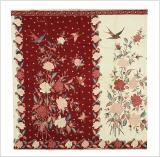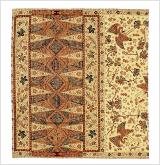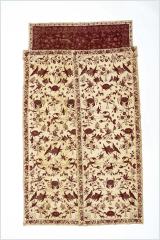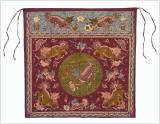Tribal and Textil Art 2021
.
.
.
.
No. 15 - Sarong
No. 15 - Sarong
104 x 190 cm
Cotton, Chemical dye
Batik Tulis, North coast, Pekalongan
1950
Edges hand sewn
Back and details Object 15

|
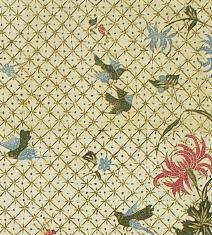
|

|
_________________________________________________________________
No. 16 - Sarong, signed “Tan Kok Hwi Pekalongan”
No. 16 - Sarong, signed “Tan Kok Hwi Pekalongan”
107 x 205 cm
Cotton, Chemical dye
Batik tulis
1970
Published in Fiona Kerlogue The book of BATIK (page 47)
“Batik produced in Pekalongan for clients of Chinese descent was often dyed in soft pastel colours similar to those found in the imported ceramics popular amongst the Chinese community. This design is cempaka warna, or coloured kamboja flowers.”
Back and details Object 16
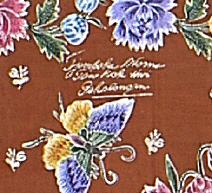
|

|
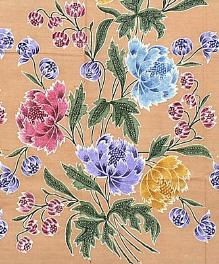
|
_________________________________________________________________
No. 17 - Sarong – signed “Lim Siam Nio Sdo”
No. 17 - Sarong – signed “Lim Siam Nio Sdo”
106 x 200 cm
Cotton, Chemical dye, exquisite work, rare
Batik tulis
1950
Sarong made in Sidohardjo , handsewn
Back and Details Object 17

|
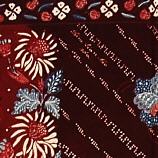
|

|
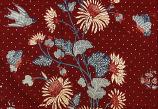
|
_________________________________________________________________
No. 18 - Sarong buketan – signed E. v. Zuylen
No. 18 - Sarong buketan – signed E. v. Zuylen
Made in Mrs. Eliza van Zuylen’s workshop (1863-1947), Pekalongan
106 x 204 cm
fine cotton, Chemical dye
Batik tulis
First quarter of 20th century
Perfect condition, no holes, handsewn
Reference
Book of Batik, Fiona Kerlogue (page 87)
Batik Traditional Textiles of Indonesia from Rudolf Smend (page 32/33)
“Kain buketan, signed ‘E v Zuylen’, made in Mrs Eliza van Zuylen’s workshop (1863-1947), Pekalongan, ca. 1930. – Because of her lengthy career as a batik entrepreneur, Mrs van Zuylen’s life and work are well documented. All the batik in the van Zuylen compound was decorated by hand (batik Tulis) to the highest standards and was distinguished by its large floral bouquets cleanly delineated against solid backgrounds, often in pastel hues, accentuated by simple diagonal lines on the badan.”
Sold
Back and Details Object 18

|
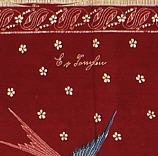
|
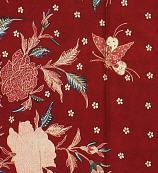
|

|
_________________________________________________________________
No. 19 - Sarong – signed E. v. Zuylen
No. 19 - Sarong – signed E. v. Zuylen
Made in Mrs. Eliza van Zuylen’s workshop (1863-1947), Pekalongan
107 x 208 cm
fine cotton, Chemical dye
Batik Tulis
1930
Good antique condition, mold stains, handsewn
Reference in the Book BATIK, Traditional Textiles of Indonesia – Rudolf Smend Collection (page 34/35)
“Kain buketan, signed ‘E v Zuylen’, made in Mrs Eliza van Zuylen’s workshop (1863-1947), Pekalongan, ca. 1930. – Because of her lengthy career as a batik entrepreneur, Mrs van Zuylen’s life and work are well documented. All the batik in the van Zuylen compound was decorated by hand (batik Tulis) to the highest standards and was distinguished by its large floral bouquets cleanly delineated against solid backgrounds, often in pastel hues, accentuated by simple diagonal lines on the badan.”
Sold
Back and Details Object 19

|

|

|
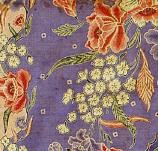
|
_________________________________________________________________
No. 20 - Sarong – signed L. Metz Pek
No. 20 - Sarong – signed L. Metz Pek
Made by Mrs. Lien Metzelar Pekalongan (ca. 1855 – 1930)
105 x 202 cm
Cotton, Chemical dye
Batik tulis
1890 – 1900
Good antique condition, mold stains, some repairs
Design: buket lung lungan
Reference see book BATIK Traditional Textiles of Indonesia, Rudolf Smend (page26)
“Mrs. Lien Metzelaar ran a well-known batik workshop in Pekalongan between 1880 und 1919, the heyday of Indische or Indo-European batik. She frequently signed her batik “L. Metz Pek”. Between 1890 and 1900, she produced a series of batik sarongs that combined colors and designs typical of two major batik centers of Java – a warm brown and mengkudu red from the Pesisir area.”
Repairs and Details Object 20

|

|

|

|
_________________________________________________________________
No. 21 - Sarong – signed L. Metz Pek
No. 21 - Sarong
107 x 195 cm
Fine cotton, natural dyes; mengkudu
Batik Tulis
First quarter of 20th century
Seam handsewn
Lasem Pasisir Area
Chinese in style and color, called bang-bangan (red)
Depicted are phoenixes. These animals have mystical powers that can be appropriated to someone wearing such a superb cloth.
Back and Details Object 21
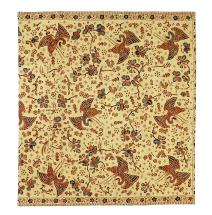
|
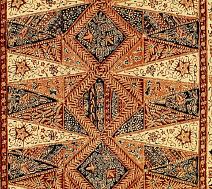
|

|
_________________________________________________________________
No. 22 - Decorative hanging
No. 22 - Decorative hanging
107 x 198 cm
Cotton
Batik tulis
1900 - 1910
Published in BATIK 75 selected masterpieces , Rudolf Smend Collection (page 138)
Created in a Javanese Chinese workshop in Semarang, North Java.
Letters in the center ‘Samarang T. Jowah’
Sold
Details Object 22

|

|
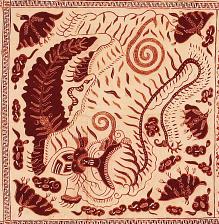
|
_________________________________________________________________
No. 23 - Decorative hanging
No. 23 - Decorative hanging
70 x 110 cm
Cotton
Batik tulis, plant dyes, great craftmanship
1900
Chinese workshop Pasisir, Lasem area
Details Object 23

|
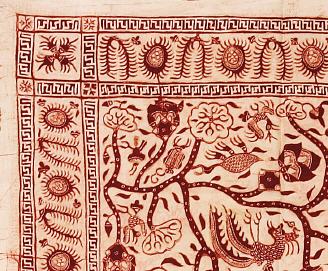
|
_________________________________________________________________
No. 24 - Door hanging
No. 24 - Door hanging
2 x 77 x 232cm (+32cm)
Cotton
Batik tulis, plant dyes
First quarter of 20th century
Chinese workshop Pasisir, Lasem area, very rare, very good condition
Published in BATIK Traditional Textiles of Indonesia from Rudolf Smend collection (page 109)
“The festive door hanging was probably used during Chinese New Year celebrations. The multitude of creatures decorating the cloth represent three realms – water (fish, prawns, crabs and turtles), land (deer, stags and chickens) and air (birds and butterflies). According to Chinese beliefs, each of these creatures adds a symbolic message or sentiment to the textile, fish symbolize plentitude and abundance, turtles a long life and butterflies summer, beauty and romance.”
Details Object 24

|
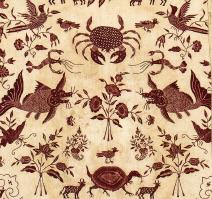
|
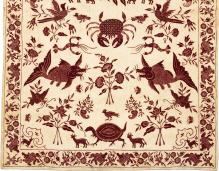
|
_________________________________________________________________
No. 25 -Tok wi
No. 25 - Tok wi, altar cloth for a Chinese house altar
104 x 104cm
Cotton
Batik tulis, chemical dyes
First half of 20th century
Pasisir area
Reference:
The book of batik, Fiona Kerlogue (page 90)
BATIK Javanese and Sumatran Batiks from Courts and Palaces, Rudolf Smend Collection (page 70)
Details Object 25

|

|
_________________________________________________________________
No. 26 - Dodot / Ceremonial cloth
No. 26 - Dodot / Ceremonial cloth
200 x 390 cm
Cotton and silk
Batik Tulis, plant dyes
first quarter of 20th century
Sultans palace, Yogyakarta
Reference:
Javanese and Sumatran Batiks from Courts and Palaces, Rudolf Smend Collection (page 38)
BATIK – 75 selected masterpieces, Rudolf Smend Collection (page78)
“A garment of this type is worn as a ceremonial skirt by the rulers of Yogyakarta and Surakarta, as well as by a bride and groom during their wedding.”
Detail Object 26

|
_________________________________________________________________
No. 27 - Ceremonial cloth
No. 27 - Ceremonial cloth – selendang bersidang
90 x 190 cm
Cotton
Batik tulis, Indigo blue
Early 20th century
South Sumatra, Jambi
Reference: The book of batik, Fiona Kerlogue (page 66)
“In Jambi, selendang with a central lozenge are known as selendang bersidang. The combination of regular rows of half-drops in the main field with a central lozenge filled with tendrils and leaves is typical, as is the triple border
Details Object 27

|
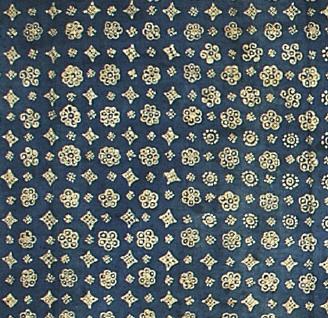
|
_________________________________________________________________
No. 28 - Selendang bersidang
No. 28 - Selendang bersidang
80 x 210 cm
Some stains, fair antique condition
Batik tulis, plant dyes
Early 20th century
Fine cotton, Tulis batik, plant dyes, indigo blue, mengkudu red and soga brown. Produced probably in Lasem around 1900 for export to South-Sumatra.
Details Object 28

|
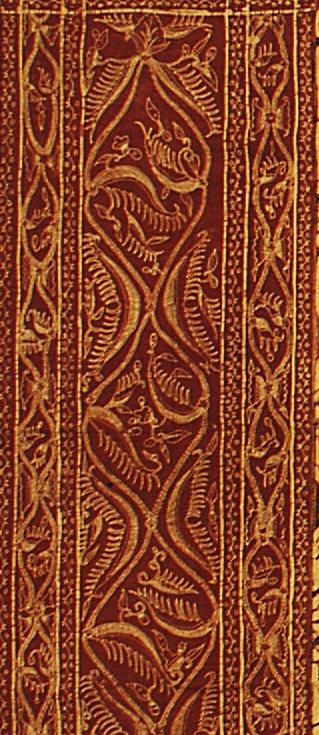
|
_________________________________________________________________
No. 29 - Sarong
No. 29 - Sarong
105 x 195 cm
Fine cotton
Batik Tulis, plant dyes
late 19th – early 20th century
Published in BATIK Traditional Textiles of Indonesia from Rudolf Smend collection (page 84/85)
“Lasem batik was once famous for its floral motifs and beautifully drawn Chinese motifs in deep red and blue on a light ground. The elaborate plants on the badan of this sarong, with their large blossoms and roots, were undoubtedly by the tree of life motif frequently found on chintz trade cloths from the Coromandel coast of India. The complex arrangement of the kepala and a very fine bow border running along the lower edge of the cloth made this sarong an exquisite festive garment.”
Sold
Details Object 29

|

|
_________________________________________________________________
No. 30 - Kain Pagi-sore signiert ‘Shann Thun Lung
No. 30 - Kain Pagi-sore signiert ‘Shann Thun Lung’
107 x 244 cm
Fine cotton
Batik Tulis, chemical dyes
1940
Reference: Fiona Kerlogue The book of batik (page 47)
“On the north coast, the two ends of skirt cloth were often separated with diagonal division. This kind of cloth was known as a kain pagi-sore (morning – afternoon) since the wearer could choose which side of the design to expose according to the time of day or the occasion.”
Sign and Detail Object 29
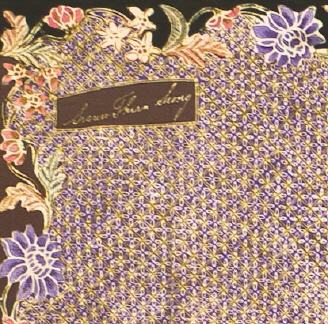
|
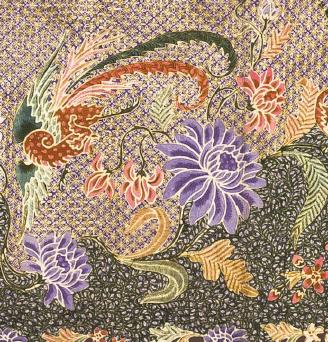
|



